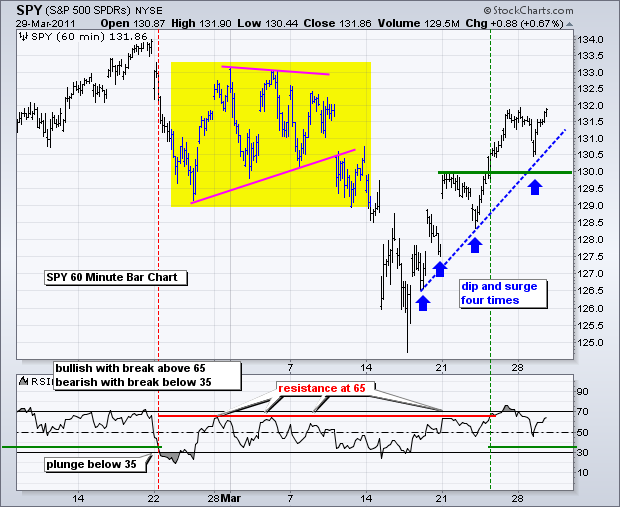"Don't fight the Tape" is an old Wall Street adage. It is as true today as it was when Jesse Livermore traded in the bucket shops. First and foremost, the overall trend on the daily and weekly charts is up and has been up for some time. Second, stocks were hammered after the events in Japan, but came roaring back. Third, the short-term trend is clearly up after a ±5% advance in nine days. Even though this trend may be overbought, it is clearly up and shows no signs of weakness.

On the 60-minute chart, there are now four pullbacks and four surges. The bulls come out even stronger after a pullback. Even though SPY has yet to exceed 132, Tuesday's post-gap surge is another sign of strong buying pressure. Traders appear to be gearing up for Friday's employment report. With this bounce, I am now elevating key support to 130. A move below the blue trendline and below key support would reverse this short-term uptrend. RSI moved into bull mode with last week's surge above 65. Notice that the indicator found support in the 40-50 zone yesterday. RSI shall remain in bull mode as long as it trades above 35.

Key Economic Reports/Events:
Wed - Mar 30 - 07:00 - MBA Mortgage Index
Wed - Mar 30 - 07:30 - Challenger Job Cuts
Wed - Mar 30 - 08:15 - ADP Employment Change
Wed - Mar 30 - 10:30 – Oil Inventories
Thu - Mar 31 - 08:30 - Jobless Claims
Thu - Mar 31 - 09:45 - Chicago PMI
Thu - Mar 31 - 10:00 - Factory Orders
Fri - Apr 01 - 08:30 - Employment Report
Fri - Apr 01 - 10:00 - ISM Index
Fri - Apr 01 - 10:00 - Construction Spending
Fri - Apr 01 - 15:00 - Auto-Truck Sales
Charts of Interest: Tuesday and Thursday in separate post.
-----------------------------------------------------------------------------
This commentary and charts-of-interest are designed to stimulate thinking. This analysis is not a recommendation to buy, sell, hold or sell short any security (stock ETF or otherwise). We all need to think for ourselves when it comes to trading our own accounts. First, it is the only way to really learn. Second, we are the only ones responsible for our decisions. Think of these charts as food for further analysis. Before making a trade, it is important to have a plan. Plan the trade and trade the plan. Among other things, this includes setting a trigger level, a target area and a stop-loss level. It is also important to plan for three possible price movements: advance, decline or sideways. Have a plan for all three scenarios BEFORE making the trade. Consider possible holding times. And finally, look at overall market conditions and sector/industry performance.






